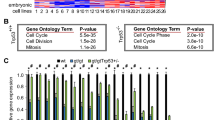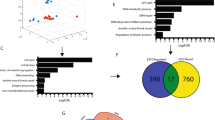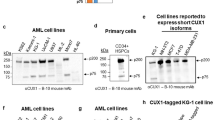Abstract
Transcription factor E2F-1 and its interaction with pRb provide a key point of control in cell proliferation. E2F-1 participates in both cell cycle progression and apoptosis, and in cells exists with a DP dimerization partner protein, the most prominent being DP-1. By mining the tumor tissue and cancer cell line encyclopedia genomic databases, we identified the first somatic mutations in the DP-1 gene and describe 53 distinct mutation events here. The mutations are mostly missense mutations, but also include nonsense and frame-shift mutations that result in truncated DP-1 derivatives. Mutation occurs throughout the DP-1 gene but generally leaves protein dimerization activity intact. This allows the mutant derivatives to affect the properties of the E2F-1/DP-1 heterodimer through a transdominant mechanism, which changes the DNA binding, transcriptional activation and pRb-binding properties of the heterodimer. In particular, many DP-1 mutants were found to impair E2F-1-dependent apoptosis. Our results establish that somatic mutations in DP-1 uncouple normal control of the E2F pathway, and thus define a new mechanism that could contribute to aberrant proliferation in tumor cells.
This is a preview of subscription content, access via your institution
Access options
Subscribe to this journal
Receive 50 print issues and online access
$259.00 per year
only $5.18 per issue
Buy this article
- Purchase on Springer Link
- Instant access to full article PDF
Prices may be subject to local taxes which are calculated during checkout





Similar content being viewed by others
References
Weinberg RA . The retinoblastoma protein and cell cycle control. Cell 1995; 81: 323–330.
Chellappan SP, Hiebert S, Mudryj M, Horowitz JM, Nevins JR . The E2F transcription factor is a cellular target for the RB protein. Cell 1991; 65: 1053–1061.
Stevens C, La Thangue NB . E2F and cell cycle control: a double-edged sword. Arch Biochem Biophys 2003; 412: 157–169.
Trimarchi JM, Lees JA . Sibling rivalry in the E2F family. Nat Rev Mol Cell Biol 2002; 3: 11–20.
Bandara LR, Lathangue NB . Adenovirus-E1a prevents the retinoblastoma gene-product from complexing with a cellular transcription factor. Nature 1991; 351: 494–497.
Dyson N . The regulation of E2F by pRB-family proteins. Genes Dev 1998; 12: 2245–2262.
Frolov MV, Dyson NJ . Molecular mechanisms of E2F-dependent activation and pRB-mediated repression. J Cell Sci 2004; 117 (Pt 11): 2173–2181.
Kohn MJ, Bronson RT, Harlow E, Dyson NJ, Yamasaki L . Dp1 is required for extra-embryonic development. Development 2003; 130: 1295–1305.
Kohn MJ, Leung SW, Criniti V, Agromayor M, Yamasaki L . Dp1 is largely dispensable for embryonic development. Mol Cell Biol 2004; 24: 7197–7205.
Polager S, Ginsberg D . E2F—at the crossroads of life and death. Trends Cell Biol 2008; 18: 528–535.
Field SJ, Tsai FY, Kuo F, Zubiaga AM, Kaelin WG Jr, Livingston DM et al. E2F-1 functions in mice to promote apoptosis and suppress proliferation. Cell 1996; 85: 549–561.
Blattner C, Sparks A, Lane D . Transcription factor E2F-1 is upregulated in response to DNA damage in a manner analogous to that of p53. Mol Cell Biol 1999; 19: 3704–3713.
Stevens C, Smith L, La Thangue NB . Chk2 activates E2F-1 in response to DNA damage. Nat Cell Biol 2003; 5: 401–409.
Biswas AK, Johnson DG . Transcriptional and nontranscriptional functions of E2F1 in response to DNA damage. Cancer Res 2012; 72: 13–17.
Polager S, Ginsberg D . p53 and E2f: partners in life and death. Nat Rev Cancer 2009; 9: 738–748.
Yu W, Chan-On W, Teo M, Ong CK, Cutcutache I, Allen GE et al. First somatic mutation of E2F1 in a critical DNA binding residue discovered in well-differentiated papillary mesothelioma of the peritoneum. Genome Biol 2011; 12: R96.
Sherr CJ . Cell cycle control and cancer. Harvey Lect 2000; 96: 73–92.
Sellers WR, Kaelin WG Jr . Role of the retinoblastoma protein in the pathogenesis of human cancer. J Clin Oncol 1997; 15: 3301–3312.
Bamford S, Dawson E, Forbes S, Clements J, Pettett R, Dogan A et al. The COSMIC (catalogue of somatic mutations in cancer) database and website. Br J Cancer 2004; 91: 355–358.
Barretina J, Caponigro G, Stransky N, Venkatesan K, Margolin AA, Kim S et al. The Cancer Cell Line Encyclopedia enables predictive modelling of anticancer drug sensitivity. Nature 2012; 483: 603–607.
Zheng N, Fraenkel E, Pabo CO, Pavletich NP . Structural basis of DNA recognition by the heterodimeric cell cycle transcription factor E2F-DP. Genes Dev 1999; 13: 666–674.
de la Luna S, Burden MJ, Lee CW, La Thangue NB . Nuclear accumulation of the E2F heterodimer regulated by subunit composition and alternative splicing of a nuclear localization signal. J Cell Sci 1996; 109 (Pt 10): 2443–2452.
Magae J, Wu CL, Illenye S, Harlow E, Heintz NH . Nuclear localization of DP and E2F transcription factors by heterodimeric partners and retinoblastoma protein family members. J Cell Sci 1996; 109 (Pt 7): 1717–1726.
Nevins JR . Transcriptional regulation. A closer look at E2F. Nature 1992; 358: 375–376.
DeGregori J, Kowalik T, Nevins JR . Cellular targets for activation by the E2F1 transcription factor include DNA synthesis- and G1/S-regulatory genes. Mol Cell Biol 1995; 15: 4215–4224.
Rubin SM, Gall AL, Zheng N, Pavletich NP . Structure of the Rb C-terminal domain bound to E2F1-DP1: a mechanism for phosphorylation-induced E2F release. Cell 2005; 123: 1093–1106.
Pediconi N, Ianari A, Costanzo A, Belloni L, Gallo R, Cimino L et al. Differential regulation of E2F1 apoptotic target genes in response to DNA damage. Nat Cell Biol 2003; 5: 552–558.
Lin WC, Lin FT, Nevins JR . Selective induction of E2F1 in response to DNA damage, mediated by ATM-dependent phosphorylation. Genes Dev 2001; 15: 1833–1844.
Lee TA, Farnham PJ . Exogenous E2F expression is growth inhibitory before, during, and after cellular transformation. Oncogene 2000; 19: 2257–2268.
Nevins JR . The Rb/E2F pathway and cancer. Hum Mol Genet 2001; 10: 699–703.
Harbour JW, Dean DC . The Rb/E2F pathway: expanding roles and emerging paradigms. Genes Dev 2000; 14: 2393–2409.
Yamasaki L . Role of the RB tumor suppressor in cancer. Cancer Treat Res 2003; 115: 209–239.
DeGregori J, Leone G, Miron A, Jakoi L, Nevins JR . Distinct roles for E2F proteins in cell growth control and apoptosis. Proc Natl Acad Sci USA 1997; 94: 7245–7250.
DeGregori J, Johnson DG . Distinct and overlapping roles for E2F family members in transcription, proliferation and apoptosis. Curr Mol Med 2006; 6: 739–748.
Bandara LR, Buck VM, Zamanian M, Johnston LH, La Thangue NB . Functional synergy between DP-1 and E2F-1 in the cell cycle-regulating transcription factor DRTF1/E2F. EMBO J 1993; 12: 4317–4324.
Bandara LR, Lam EW, Sorensen TS, Zamanian M, Girling R, La Thangue NB . DP-1: a cell cycle-regulated and phosphorylated component of transcription factor DRTF1/E2F which is functionally important for recognition by pRb and the adenovirus E4 orf 6/7 protein. EMBO J 1994; 13: 3104–3114.
Milton A, Luoto K, Ingram L, Munro S, Logan N, Graham AL et al. A functionally distinct member of the DP family of E2F subunits. Oncogene 2006; 25: 3212–3218.
Hateboer G, Wobst A, Petersen BO, Le Cam L, Vigo E, Sardet C et al. Cell cycle-regulated expression of mammalian CDC6 is dependent on E2F. Mol Cell Biol 1998; 18: 6679–6697.
Moroni MC, Hickman ES, Lazzerini Denchi E, Caprara G, Colli E, Cecconi F et al. Apaf-1 is a transcriptional target for E2F and p53. Nat Cell Biol 2001; 3: 552–558.
Botz J, Zerfass-Thome K, Spitkovsky D, Delius H, Vogt B, Eilers M et al. Cell cycle regulation of the murine cyclin E gene depends on an E2F binding site in the promoter. Mol Cell Biol 1996; 16: 3401–3409.
Markham D, Munro S, Soloway J, O’Connor DP, La Thangue NB . DNA-damage-responsive acetylation of pRb regulates binding to E2F-1. EMBO Rep 2006; 7: 192–198.
Munro S, Khaire N, Inche A, Carr S, La Thangue NB . Lysine methylation regulates the pRb tumour suppressor protein. Oncogene 2010; 29: 2357–2367.
Acknowledgements
This work was supported by grants from CRUK (programme award C300/A13058), MRC, LLR, EU, Oxford NIHR BRU and Bayer Healthcare. We thank Sarah Atkinson for her help with preparing the manuscript.
Author Contributions
SM designed, performed and interpreted the experiments. UO performed the structural analysis. NBLT and SM wrote the manuscript. NBLT directed the project.
Author information
Authors and Affiliations
Corresponding author
Ethics declarations
Competing interests
The authors declare no conflict of interest.
Additional information
Supplementary Information accompanies this paper on the Oncogene website
Rights and permissions
About this article
Cite this article
Munro, S., Oppermann, U. & La Thangue, N. Pleiotropic effect of somatic mutations in the E2F subunit DP-1 gene in human cancer. Oncogene 33, 3594–3603 (2014). https://doi.org/10.1038/onc.2013.316
Received:
Revised:
Accepted:
Published:
Issue Date:
DOI: https://doi.org/10.1038/onc.2013.316



